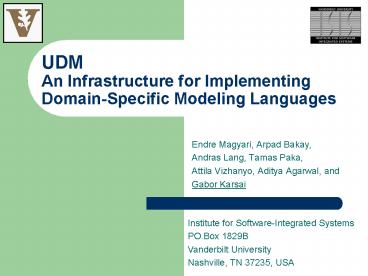UDM An Infrastructure for Implementing DomainSpecific Modeling Languages - PowerPoint PPT Presentation
1 / 10
Title:
UDM An Infrastructure for Implementing DomainSpecific Modeling Languages
Description:
Platform Independent Model: a view of the system from a ... Models undergo transformations during development that lead to executables. Domain-Specific MDA ... – PowerPoint PPT presentation
Number of Views:63
Avg rating:3.0/5.0
Title: UDM An Infrastructure for Implementing DomainSpecific Modeling Languages
1
UDM An Infrastructure for Implementing
Domain-Specific Modeling Languages
- Endre Magyari, Arpad Bakay,
- Andras Lang, Tamas Paka,
- Attila Vizhanyo, Aditya Agarwal, and
- Gabor Karsai
Institute for Software-Integrated Systems PO.Box
1829B Vanderbilt University Nashville, TN 37235,
USA
2
Overview
- Domain-Specific MDA
- Model-driven Development Tool Integration
- UDM Unified Data Model
- Framework architecture
- Metamodeling, generator, back-ends
- Capabilities
- Metaprogrammability, multiple backends,
reflection - Lessons learned
3
Model-Driven ArchitectureA Transformational
Paradigm for Software Development
- Development process
- Platform Independent Model a view of the system
from a platform independent viewpoint - Platform Specific Model a view of the system
from a platform-specific viewpoint - Key points
- Relevant issue platform-independence
- Platform Specific information is used
- Transformations are models
- MDA in a Domain-Specific context
- Models are not accidental but essential to system
development - Models are expressed in modeling languages which
are, in turn, defined in terms of a meta-model - Models undergo transformations during development
that lead to executables
Source MDA Guide V 1.0.1 (www.omg.org)
4
Domain-Specific MDADomain-Specific MDA -
Model-Integrated Computing
Metamodeling
Tool Integration
Analysis
Metamodels
Domain models
Translation
Domain-specific modeling
Synthesis Generation
Model-Model Transformations
Execution
Need uniform, configurable data layer
5
The UDM Framework
Metamodeling of data UML class diagrams
Backends Generic object implementation
API Code Generator Builds C handle classes
Constraint checker OCL evaluator
Reflection Meta-objects
6
UDM Metamodeling and generation
class Rel public Object public static
UmlClass meta Rel() // Other
constructors static Rel Create(...)
class B public A public static
UmlClass meta B() // Other constructors
static B Create(...) UdmAssocAttrltutes
tCgt dst() const class C public
Object public static UmlClass meta
C() // Other constructors static C
Create(...) UdmAssocAttrltutestBgt src()
const UdmParentAttrltutestAgt parent()
const
namespace utest class A class Rel class B
class C class A public Object public
static UmlClass meta A() // Other
constructors static A Create(...)
UdmChildrenAttrltutestCgt children() const
7
UDM Backends
GEN
DTD
METAMODEL
UDM BACK-END
METADATA
DOM
XML
- C API
- Classes
- Attributes
- Associations
Custom Interface
GME
GME
MEM
FILE
Uniform Interface
CORBA
NETWORK
8
UDM Capabilities
- Metaprogrammability
- Data structures are fully defined by the
(meta)model - Consistency rules define well-formedness
- Multiple backends
- DOM/XML Data is persisted as XML files
- GME/MGA Direct access to model databases
- MEM Fast/simple objects binary files
- CORBA/NET Compact network format for data
exchange - Reflection
- All UDM Objects have a meta attribute pointing
to a meta objects (instance of UmlClass or
UmlAssoc) - The Uml metamodel is always included
- APIs are available for discovery and generic
operations
9
UDM UML meta-metamodel
10
Lessons learned
- Generic packages (like UDM) are essential if a
large number of data models are used - Example tool integration framework
- Performance penalty is acceptable
- Uniform access means no change when switching
backends (XML, GME, CORBA, etc.) - Generic text interface (parsers and unparsers)
are also feasible and useful - Consistency checking of data structures (via OCL)
offers new ways for ensuring data integrity - Generic (internal) APIs allow generic tools































